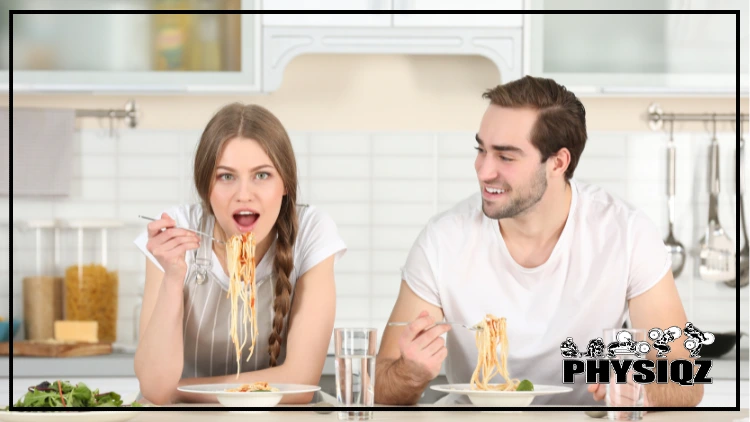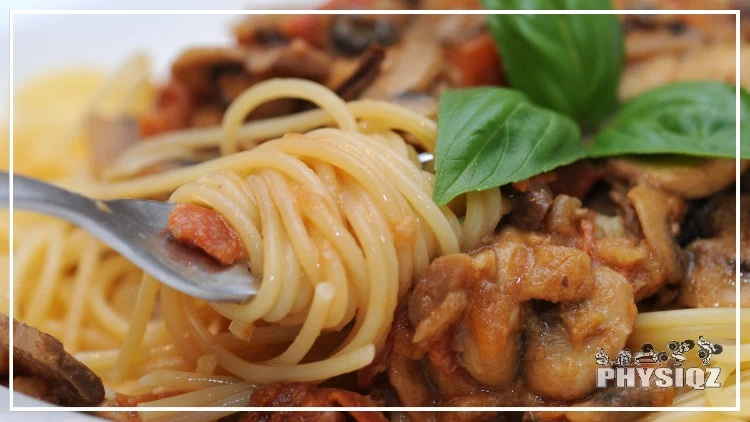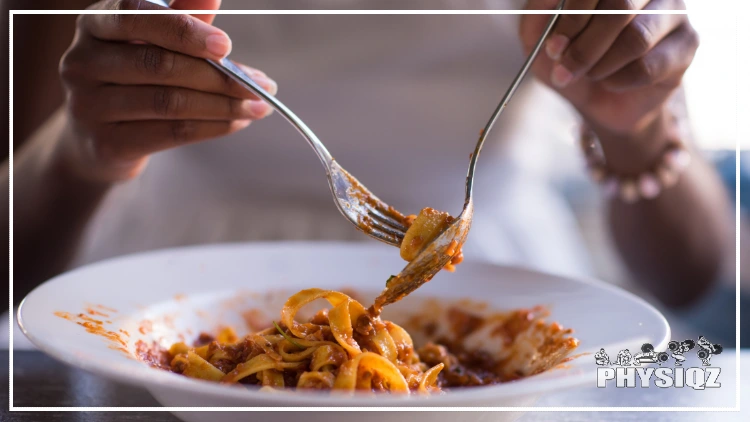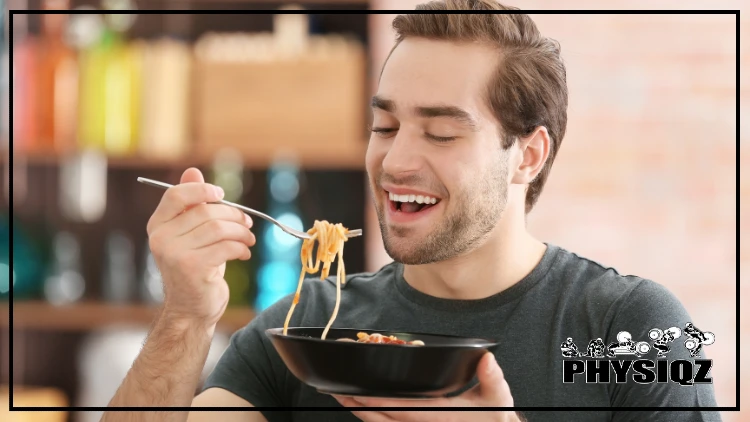
Pasta is often recommended for bulking, especially by bodybuilders who follow the dirty bulking method or the If It Fits Your Macros (IIFYM) approach.1 However, while pasta can contribute to increased calorie intake, it’s worth noting that numerous other foods may be more beneficial for bulking due to their superior macro and micronutrient profiles. This includes both pasta noodles and various pasta dishes.
On the other hand, they’re somewhat right since pasta can be good for bulking due to it’s protein, carbs and calories; but chicken, rice and other dishes with healthier ingredients, more micronutrients and more favorable macronutrients reign superior. For this reason, we’ll list a full list of the best foods that are truly good for bulking.
But first, let’s take a look at how specific pasta dishes can be good or bad for bulking by looking at four things: macronutrients, micronutrients, calories and nutrient timing.
What Makes a Pasta Dish Good or Bad for Bulking?
A pasta dish can be good or bad for bulking depending on what kind of ingredients it is made out of.

Source: dlerick via Canva.com2
For example, if a person is eating pasta made with shirataki noodles, they will struggle to put on weight. Shirataki is a type of mushroom, and each serving of shirataki noodles has around 5 calories; a typical serving of enriched pasta, on the other hand, has about 150 calories.3
On the other hand, spaghetti contains a lot of calories and protein due to the beef, which raises questions about how macronutrients fit into this puzzle.
Macronutrients (Protein, Carbs, & Fats)
The macronutrient profile of a pasta dish will depend on the ingredients and sauces used. A plate of spaghetti with marinara sauce is going to have more carbohydrates than proteins, while something like sausage-stuffed shells may have more fats.
Generally speaking, most pasta dishes are carbohydrate dense (especially with creamy sauce options) and can offer a good amount of calories when eaten in larger portions. However, the low protein content of many pasta dishes is a big negative when it comes to bulking up; proteins are essential for muscle growth and recovery and are best consumed in adequate amounts during meals.
So, prioritizing pasta dishes that incorporate some sort of protein – whether by using high-protein chickpea noodles or adding a protein like chicken or sausage, it is vital to do so when bulking.
Micronutrients (Vitamins, Minerals, Phytonutrients etc.)
The micronutrient profile of a pasta dish can vary depending on what’s in it. For example, whole-grain plates of pasta are going to offer more vitamins and minerals than white pasta or shirataki noodles.
Additionally, adding vegetables like spinach or broccoli will help boost the overall nutrient content of the meal.
While most people do not traditionally consider the micronutrients in their pasta dishes, it is indeed something that should be noted. If a lifter is eating a high-calorie, high-protein pasta dish, sure, they will probably gain some strength; but if it is completely devoid of any micronutrients, then the overall returns from eating it will be relatively limited.
Calories (Must Be In a Caloric Surplus When Bulking)
To gain weight, a person needs to consume more calories than they burn, and pasta dishes can help achieve this. This highlights the important lesson that the number on the scale isn’t everything.
In terms of calories, some typical pasta dishes (without sauce) will provide anywhere between 100-200 calories per serving.
Depending on the ingredients used and the portion size, that number can go up or down. As long as a person is mindful of their calorie consumption over the course of the day, pasta dishes can still be beneficial when it comes to bulking.
The Benefits of Pasta for Bulking Up
Pasta dishes can be good for bulking so long as a person is aware of the macronutrients, micronutrients, and calories contained in their meals. However, there are better foods for bulking below.

Source: dotshock on Shutterstock4
The Pros & Cons of Eating Pasta While Bulking
As mentioned, pasta can be good for bulking but understanding the pros and cons of pasta dishes can help anyone make a decision if it’s worth including in their diet.
Pros & Bulking Benefits of Pasta:
- Can be high in protein and high in calories, allowing a bodybuilder to gain weight
- When the proper ingredients are added, like spinach, the micronutrient profile is good
- Low in fiber, allowing lifters to eat quite a bit of pasta before feeling satiated
Cons & Downsides of Pasta When Bulking:
- Without a high protein pasta or adding a protein to a pasta dish, can be low in protein and micronutrients, so it’s important to add other ingredients
- Easy to over consume calories as pasta dishes can be quite calorie dense
Overall, pasta dishes can be a great addition to any bulk diet when done correctly. Make sure that the majority of calories come from nutritious sources, like lean proteins and carbohydrates, as well as some healthy fats.
Also, add vegetables or nutrient-rich sauces to incorporate micronutrients into the dishes. Finally, be mindful of portion sizes to ensure the right amount of calories is consumed.
Nutrient Timing of Pasta When Bodybuilding: When Is the Best Time To Eat Pasta When Bulking?
Similar to the timing of protein shakes for weight loss, there is ample research on nutrient timing for optimal resistance training. The majority of the literature conclude that consuming carbohydrates, proteins, or BCAAs before a workout has no effect on the workout itself, while post-workout consumption of protein and carbohydrates significantly enhances the quality of the next workout.5
For those looking to bulk up, it’s important to eat pasta dishes within a few hours after completing a workout to ensure they recover adequately for their next session.
What’s the Best Type of Pasta Dish for Bulking?
The best pasta dishes for bulking vary depending on the ingredients and what type of diet a person is following. For those looking to bulk up, the typical recommendation is to use some sort of high-calorie, high-protein pasta like whole wheat or protein-rich noodles, like chickpea.
Additionally, adding some type of healthy fat source, like olive oil, and incorporating some sort of vegetable, like spinach or broccoli, will ensure that the dish is packed with nutrients.
Then of course, any meat such as chicken, sausage, or beef can work for the protein side of things.
A Review of Common Pasta Dishes & if Their Nutritional Value Is Good for Bulking
For the sake of this article, three sample pasta dishes have been selected that all have high calories, high protein, and some micronutrients. For those considering creating a variation of one of these dishes, do note that any ingredients can be substituted for a close variation if a person wants to make the dishes higher calorie, lower calorie, higher protein, or something else.
Chicken Fettuccine Alfredo Nutritional Information
A high-calorie Chicken Fettuccine Alfredo dish is made with lots of parmesan cheese, heavy cream, fettuccine noodles, spinach, and chicken. The average version of this totals in with the following nutrients:6
- Calories: 1440
- Fat(g): 92.5
- Carbs(g): 95
- Protein(g): 56
Pasta is indeed a suitable option for bulking up. The calories can be modulated by changing the type of noodles used to higher protein noodles, or even removing the heavy cream and adding a lower calorie substitute, like milk or water.
Chicken Pasta’s Macros & Calories
A chicken pasta dish is simply a type of pasta combined with chicken breasts or thighs, a sauce made from eggs, heavy cream, cheese, and olive oil, and the addition of a vegetable like mushrooms to add some micronutrients.
A sample version of Chicken Pasta, made with 12 ounces of chicken, 12 ounces of gluten-free pasta, around 24 ounces of mushrooms, and a mixture of olive oil, eggs, and cheese, totals in at:
- Calories: 1000
- Fat(g): 35
- Carbs(g): 106
- Protein(g): 62
This pasta dish is the ultimate combination of high calories and high protein, with a lower fat content offering the ability to eat a larger volume of the pasta without feeling overly satiated
Ground Beef & Quinoa Pasta
This pasta dish is quite simple; it’s a combination of quinoa pasta, which is an extremely functionally nutritional grain, ground beef, tomatoes, and basil, offering it a moderate micronutrient profile from the tomatoes, basil, and quinoa, and a good source of protein from the quinoa and beef.7 Nutritionally, here is how it stacks up:
- Calories: 850
- Fat(g): 13
- Carbs(g): 132
- Protein(g): 44
Clearly, this dish has less protein than the others, so switching to a leaner protein like chicken could be a good move for those with a higher body weight. Apart from that, those curious about the benefits of quinoa for weight loss will find it a valuable addition to this pasta dish.
A List of the Best Foods for Bulking
Many people inquire about the effectiveness of various foods for bulking, including pasta, rice, milk, and oatmeal. Foods that are beneficial for bulking typically contain valuable macro and micronutrients and are minimally processed. See this full list of good foods for bulking before your next visit to the grocery store.
| Is (Are) ___Good for Bulking? | Yes / No |
| Is Rice Good for Bulking | Yes |
| Is Chicken Good for Bulking? | Yes |
| Is Milk Good for Bulking? | Yes |
| Is Peanut Butter Good for Bulking? | Yes |
| Is Oatmeal Good for Bulking? | Yes |
| Is Olive Oil Good for Bulking? | Yes |
| Is Bacon Good for Bulking? | Yes |
| Is Creatine Good for Bulking? | Yes |
| Is Spaghetti Good for Bulking? | Yes |
| Is Popcorn Good for Bulking? | Yes |
| Is Cheese Good for Bulking? | Yes |
| Are Eggs Good for Bulking? | Yes |
| Is Salad (Lettuce, Romaine, Spinach, Kale, Arugula, Chard, Mustard Greens etc.) Good for Bulking? | Yes |
| Is Beef Good for Bulking? | Yes |
| Are Beans Good for Bulking? | Yes |
| Is Tuna Good for Bulking? | Yes |
| Is Quinoa Good for Bulking? | Yes |
| Is White Rice Good for Bulking? | Yes |
| Is Brown Rice Good for Bulking? | Yes |
| Is Fruit Good for Bulking? | Yes |
| Are Potatoes Good for Bulking? | Yes |
| Is Broccoli Good for Bulking? | Yes |
| Are Nuts Good for Bulking? | Yes |
| Are Seeds Good for Bulking? | Yes |
| Are Beans & Legumes Good for Bulking? | Yes |
| Is Yogurt Good for Bulking? | Yes |
| Is Granola Good for Bulking? | Yes |
| Are Avocados Good for Bulking? | Yes |
| Is Coconut Oil Good for Bulking? | Yes |
| Is Salmon Good for Bulking? | Yes |
| Are Protein Shakes Good for Bulking? | Yes |
| Is Fish Oil Good for Bulking? | Yes |
| Is Dried Food Good for Bulking? | Yes |
A List of the Worst Foods for Bulking
On the flipside of the coin, there are also quite a few common foods that people think are good for bulking, but are actually quite bad due to things like poor micronutrient makeup and a lack of protein.
| Is (Are) ___Good for Bulking? | Yes / No |
| Is Bread Good for Bulking? | No |
| Is Pizza Good for Bulking? | Not Really |
| Is Ice Cream Good for Bulking? | No |
| Is Beer Good for Bulking? | No |
| Is Cereal Good for Bulking? | No |
| Is Ramen Good for Bulking? | No |
| Is Chocolate Milk Good for Bulking? | No |
| Is Fast Food Good for Bulking? | No |
| Is Milk Chocolate Good for Bulking? | No |
| Is Candy Good for Bulking? | No |
| Is Sugar Good for Bulking? | No |
| Are French Fries Good for Bulking? | No |
| Is Fried Food Good for Bulking? | No |
| Are Chips Good for Bulking? | No |
| Is Cake Good for Bulking? | No |
| Are Cookies Good for Bulking? | No |
| Is White Bread Good for Bulking? | No |
| Is Ketchup Good for Bulking? | No |
| Is BBQ Sauce Good for Bulking? | No |
| Are Cupcakes Good for Bulking? | No |
| Is Butter Good for Bulking? | No |
| Are Onion Rings Good for Bulking? | No |
| Is Mayonnaise Good for Bulking? | No |
| Are Pancakes Good for Bulking? | No |
| Is French Toast Good for Bulking? | No |
| Are Mozzarella Sticks Good for Bulking? | No |
| Are Donuts Good for Bulking? | No |
| Are Ramen Noodles or Cup Noodles Good for Bulking? | No |
| Are Girl Scout Cookies Good for Bulking? | No |
| Are Toaster Strudels Good for Bulking? | No |
| Are Pop Tarts Good for Bulking? | No |
For a lifter aiming to pursue dirty bulking, these foods could be ideal, though the concept itself may require some clarification.
What Is Dirty Bulking?
Dirty bulking is a term that simply means someone is eating a lot of food, mostly unhealthy food, and then trying to gain muscle mass by eating a lot of it. For some people, intuitive eating can lead to weight loss. However, more often, it results in consuming a large amount of food, causing the lifter to engage in a dirty bulk.
Lots of influencers and bodybuilders use this technique, and it can be effective if done properly. For those who want to fully commit to a bulk but don’t want to go through the work of tracking calories, or if someone is simply giving up on weight loss, dirty bulking is the way to go.
When referring to eating pasta, dirty bulking can involve consuming higher calorie versions of the food, like Fettuccine Alfredo. Eating these dishes in moderation is necessary, but it can help someone gain weight quickly and efficiently if needed.
How To Intelligently Incorporate Pasta When Bulking
To properly eat pasta when trying to bulk, weightlifters should take a few things into account. Before discussing the actual methods, it’s important to consider the mindset: understanding the timeline for achieving the perfect body depends on the lifter’s awareness of their specific goals.
If they need to gain a lot of muscle, or if they need to lose a lot of fat, then they need to adjust the way they craft their pasta dishes accordingly.

Source: pixelshot via Canva.com8
Moving forward, for lifters, the timing of eating the pasta dish is key. As aforementioned, eating pre-workout doesn’t seem to have that strong of an effect on performance mid-workout, but a post-workout meal that has protein and carbs is important.
Using pasta as a way to fuel a beginner hypertrophy program would certainly be a good idea.
Next, choosing better white pasta and wheat pasta is something that people can experiment with.
Some lifters find that white pasta has a better effect on their weightlifting goals than wheat pasta, whereas others disagree and argue that wheat pasta is overall better for their digestive system. Taking time to determine which type of pasta is best for the individual is important.
Using Different Foods to Bulk Properly
As mentioned above, there are many different ways to bulk. Dirty bulking would involve a person eating less nutritionally-dense foods in favor of consuming a lot of calories.
This would allow them to easily get in a caloric surplus, but it can easily snowball into creating other problematic factors like gaining weight too quickly, not eating enough protein, and in some cases, developing other body ailments. For example, consuming too many processed foods could lead to increased acne.
On the other side of bulking, a lifter could focus on IIFYM, “If It Fits Your Macros”, where they can eat anything as long as they hit their macronutrient goals for the day. This is similar to dirty bulking, but more often than not, people tend to be more restrictive with their diet, cutting out processed foods and focusing on hitting a high protein count.
This also allows them to worry less about what they’re eating, only adding the restrictions of X amount of protein and no processed foods.
There is no one correct way to do any of these bulking methods. The only thing to keep in mind is that each individual person has an ‘optimal’ method to gain weight, even if they don’t know it yet.
But, some bulking methods may be more ‘healthy’ than others, and eating pasta dishes properly can be one of those healthy ways.
Combining proper meal timing, dirty bulking, enriching pasta dishes with high-protein ingredients, and including vegetables for essential micronutrients is crucial for those looking to bulk up effectively with pasta.
Frequently Asked Questions
Is Whole Wheat or White Pasta Better for Bulking?
This is a personal preference. Generally, whole wheat pasta has more fiber, which can be beneficial if someone is looking to increase their fiber intake, but both kinds of pasta offer similar nutrients for the most part.
What Are Some of the Best Sources of Carbs When Bulking?
Complex carbs are found in raw foods like potatoes and are some of the best sources of carbohydrates out there. Simple carbs, on the other hand, are refined carbohydrates like potato chips and pasta that have been stripped of some of their natural nutrients; while these can be good for short bursts of energy, they have been shown to sustain energy for less time than complex carbs.
What Is The GOMAD Diet?
GOMAD is an acronym for “Gallon Of Milk A Day”, and it’s a diet commonly used by bodybuilders who are trying to bulk up quickly. It involves consuming a gallon of whole milk every day, along with a high-calorie diet, in order to gain muscle mass quickly. However, this diet is not recommended for those looking to lose weight as it can lead to excess fat gains if a person is not working out frequently.
Are Pasta Noodles Good for Bulking?
Pasta noodles are mainly comprised of flour which is a complex carb that digests quickly due to the high glycemic index. For this reason, pasta noodles can be good for bulking if timed before or after a workout but more wholesome carbs like rice and potatoes is best.
References
1pixelshot. Canva. Accessed 19 April 2023. <https://www.canva.com/photos/MAD-UHALA2E-young-couple-eating-pasta-on-kitchen-table/>
2dlerick. Canva. Accessed 19 April 2023. <https://www.canva.com/photos/MAEFgr-yVi4-linguini-pasta-dish/>
3The U.S. Department of Agriculture. (n.d.). FoodData Central Search Results. FoodData Central. Retrieved December 13, 2022, from <https://fdc.nal.usda.gov/fdc-app.html#/food-details/169751/nutrients>
4“Young Beautiful African American Woman Enjoys Stock Photo 504292651.” Shutterstock. Accessed 19 April 2023. <https://www.shutterstock.com/image-photo/young-beautiful-african-american-woman-enjoys-504292651>
5Campbell, B., Wilborn, C., La Bounty, P., & Wilson, J. (2012). Nutrient Timing for Resistance Exercise. Strength and Conditioning Journal, 34(4), 2-10. <https://journals.lww.com/nsca-scj/FullText/2012/08000/Nutrient_Timing_for_Resistance_Exercise.2.aspx>
6NUTRITION INFORMATION. (n.d.). Olive Garden. Retrieved December 13, 2022, from <https://media.olivegarden.com/en_us/pdf/olive_garden_nutrition.pdf>
7Vega-Galvez, A., Miranda, M., Vergara, J., Uribe, E., Puente, L., & Martinez, E. (2010). Nutrition facts and functional potential of quinoa (Chenopodium quinoa willd.), an ancient Andean grain: a review. Journal of the Science of Food and Agriculture, 90(15), 2541-7. <https://pubmed.ncbi.nlm.nih.gov/20814881/>
8pixelshot. Canva. Accessed 19 April 2023. <https://www.canva.com/photos/MAD-UI0RNR0-young-man-eating-pasta-at-table/>